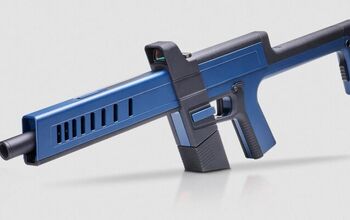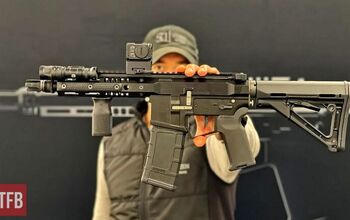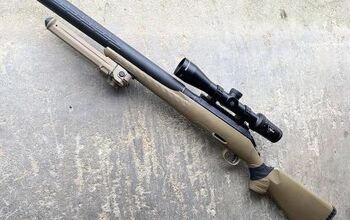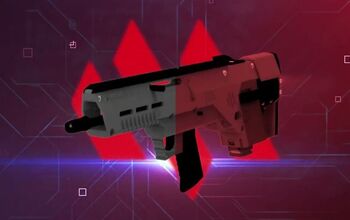Silencer Saturday #373: A "Class Tree" Wooden Silencer

Good afternoon everyone and welcome back to TFB’s Silencer Saturday, brought to you by Yankee Hill Machine, manufacturers of the new YHM R45 Multi-Host Suppressor. This week we are looking at a very unique project: a Form 1 wooden silencer. The “Wood UB Quiet” suppressor is a very interesting approach to silencer construction.
Silencer Saturday @ TFB:
- Silencer Saturday #372: Centurion Arms Maximus-L
- Silencer Saturday #371: PSA Gets Into Silencer Sales
- Silencer Saturday #370: Silencer Mounting Overview
- Silencer Saturday #369: ATF Silencer Industry Data
- Silencer Saturday #368: Breaking Down Nielsen Devices
We have all heard stories or seen movie depictions of DIY silencers made from uncommon objects. From the soda bottle on a .22 LR rifle in the movie Shooter to the oil filter silencers in Call of Duty: Modern Warfare (2019), or using a pillow to hide a gunshot noise ( tested here by the wonderful Jerry Miculek), there are many examples of nontraditional methods of quieting a gunshot.
A very original one hit my email recently and it seemed like something this audience would really enjoy. Fellow silencer enthusiast Jeremy decided to make a wooden silencer. This is a wonderfully wacky undertaking and this seemed like a nice change of pace from advanced materials and additive manufacturing. Here he is in his own words:
“Wood UB Quiet” - A Suppressor Made From Wood
I've been exploring all things laser cutting over the last year or so with a 20 watt diode laser that a friend loaned me.
I had this random idea of creating a rimfire suppressor by laminating pieces of laser cut plywood. "Wood" it be possible to make a functional rimfire suppressor from laser cut plywood? Even the mounting point could be wood. Would threads in the layers of wood hold? There is only one way to find out!
The question here is not about building a practical rugged long lasting serviceable suppressor. If that is the first thing you thought about, then you should stop reading now as you may experience more emotional discomfort if you continue.
This is an exploration into what is possible with non traditional suppressor materials and techniques. It's also fun to think about a future where suppressors are not regulated and cheap disposable (biodegradable) suppressors might make sense. From what I could find in my limited research nobody has admitted to trying this yet. That is reason alone to do it.
Suppressing .22 LR is trivial and gets you the least bang for the buck. [groan]
Winters are long in the upper Midwest and projects like this are what happens. You can only watch so much disappointing Shot Show coverage of manufacturers failing to innovate. More tactical lever actions? New old style revolvers? Optics on revolvers? Proprietary parts $$$ ARs with minimal advantages over existing proven designs? [Yawn] S&W seems to be trying to have the most SKUs available at one time. The Daewoo K2 is the exception to not being boring. :) TFB does a great job making it entertaining regardless.
Back to the project. I drew up the concept in CAD knowing that if I was going to submit this as a Form 1 to the ATF there might be questions without a picture provided.
For the Additional Description on the Form 1 I wrote: “Made from layers of laser cut high quality plywood held together with glue and/or 4 threaded tension rods. See drawing.”
I also included the CAD drawing of the parts.
To my surprise, nobody asked any questions and approved the Form 1 in less than 2 weeks.
I was expecting there to be some concerns about no metal in the “firearm” if I only glued it together and skipped the threaded rods. This makes me wonder how close they look at these.
I decided on using threaded rods as I wanted to be able to take it apart and inspect the inside after testing assuming it didn’t come apart during testing.
Time to get cutting!!!!
The layers are made from high quality 5/32" (.141” actual) hobby plywood from Home Depot. This is the birch variety and doesn't have voids like some cheap plywoods. It's intended for use in laser cutters and CNC routers.
I am not an engineer but it is square so that with the tension rods there is equal thickness of material surrounding the inside of the suppressor. It won’t roll off the table either. Maybe I am an engineer?
Laser Cutting Time: 32 Minutes
Supply Cost: $8 in wood and hardware
ATF NFA Tax: $200
Model: Wood UB Quiet
Caliber: .22 LR
Weight: 6.15 oz
Length: 6.5”
Width: 1.5”
Inside Chamber: 1”
Baffles: 7
Life Span: TBD
I used 8-32 threaded rods with washers and nuts to hold everything together torqued to 10 in-lbs. That seemed about right and started to compress the wood a little. I believe glue alone could work. Glued dowels might also be an option. But this seemed like a better option to ensure alignment and no chance of delamination.
For attaching to a host firearm there are 4 layers (approx ½”) of wood that I tapped using a ½-28 tap. I cut the hole to the drill size for ½-28 threads. The wood is soft enough that you could use a host weapon to thread it carefully if you could keep things straight. I mostly eyeballed it with a small square next to the tap and held the wood in a vice. If there is a slight baffle strike it should just make its own path, right?
Will it suppress? Will it come apart in a fabulous display of splinters? Off the range to find out!!!!
Ammo used for test is 40 grain CCI Clean Subsonic.
I started with it mounted on a rifle so it was far from my face and hands if something went wrong.
The first couple shots were quiet and everything held together. I then moved it to the Ruger MKIV. I fired a total of 25 rounds. A few of the rounds were rapid fire and no first round pop was detected.
I then compared it to a Dead Air Mask side by side. I consider the Mask to be the can to beat for performance in suppressed .22LR. While it wasn’t quieter than the Mask it was still quiet but with a lower tone. Unless shooting them side by side, I don’t think you’d be able to tell it was slightly louder.
I didn’t want to move into testing its limits before inspecting the inside after 25 rounds so that was enough for initial testing for the day. I didn’t waste $200 or my time. [debatable I suppose]
At this point I call it a success!!!!
Now to inspect the insides.
The first baffle. Not bad! I really expected it to be shredded.
The second baffle looked good too but had lots of “stuff” accumulated. Unburned powder? Bits of wood?
By the 3rd baffle there was evidence of some bullet contact. It made a path without blowing anything up. There was also a little rubbing on the exit hole of the suppressor. I didn’t get things perfectly aligned but it didn’t seem to hurt much. We’ll call it a “self-centering” feature. I’m sure this all is due to the threads in the wood. That just isn’t ideal for precision alignment.
Summary: It is possible. It does work. Next will be to see how many rounds it holds up to. What is its lifespan?
I’ll figure that out over the course of future range trips. I’ll keep track of the round count and report back if/when it fails. There is part of me that wants to try to get it to start on fire.
Ok, now to address the inevitable comments:
Yes, you could use washers for baffles. But then it wouldn’t be a wood suppressor would it?
Yes, I spent $200 on a tax stamp just to test this not knowing if it’d work.
Yes, there are many things that could be improved with the design. I hope this inspires you to go out and make a better one or make something completely new!
Yes, it’s ridiculous these are still regulated. That is the law (right or wrong) and we must follow it.
Update: As of the last update he was up to 100 rounds fired and still going strong!
Jeremy put the files for the Wood UB Quiet up on Etsy, where they lasted all of six hours before being pulled down. Interestingly, he noticed that the terms and conditions prohibited guns and firearms before he posted, but once his files were down the terms included a prohibition on silencers. So take note, DIY silencer fans, that Etsy is not a welcoming space for adventures in Form 1 suppressors. But on a totally unrelated note, there is a file for $2.99 on Etsy for “ Laser Cut Files For Wood Spacers” that you might find interesting.
We will end with a note that this kind of project should only be undertaken by someone who understands both the inherent risks and the legal systems that govern silencers. Making your own suppressor without the right paperwork is a felony in the United States so do your homework before you attempt anything similar. Also be careful and make sure you wear your eye protection! A fun project like this becomes very not fun if someone loses an eye or hand in the process, so take all appropriate safety steps.
Thank you Jeremy for sharing your project and pictures with us. He will likely be in the comments if anyone wants to pick his brain. See you next week for another round of Silencer Saturday.
SILENCER SHOP – HANSOHN BROTHERS – DEADEYE GUNS
MAC TACTICAL
ALL YHM PRODUCTS AT BROWNELLS
DEALERS: If you want your link to buy YHM suppressors included in future Silencer Saturday posts, email: silencers@thefirearmblog.com

AKA @fromtheguncounter on Instagram. Gun nerd, reloader, attorney, and mediocre hunter.
More by Daniel Y


































![[SHOT 2025] Brownells Shows BRN-180 Gen 3](https://cdn-fastly.thefirearmblog.com/media/2025/02/01/01291/shot-2025-brownells-shows-brn-180-gen-3.jpg?size=350x220)
Comments
Join the conversation
Huh...there's something you don't see every day...
Great article. I enjoy your curiosity and following through with a prototype. Keep us posted on future testing.